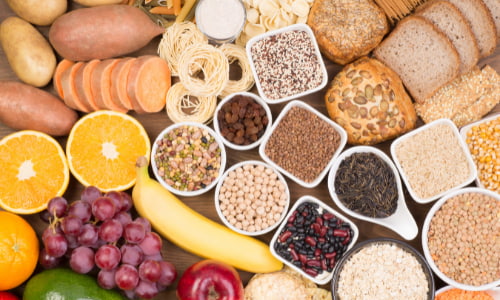Dietitian Approved High Fiber Low Carb Foods + Free Printable
“Dietitian Approved High Fiber Low Carb Foods + Free Printable” was written by Nina Deuschle, MS, RD & edited/reviewed by Aly Bouzek, MS, RDN.
If you are following a low carb diet, it can be difficult to also If you are trying to follow a lower carb diet, it can feel difficult to fit plenty of fiber in. This is due to the fact that fiber is found in carbohydrate-containing foods.
The truth? We have access to plenty of foods that are high in fiber but not extremely high in carbohydrates!
Most people in the United States aren’t getting enough fiber. Experts estimate that the average American eats about 15 grams of fiber daily, which is significantly lower than the recommendation.
Before we can discuss this issue and how it can be tackled, let’s learn more about carbohydrates and fiber.
Don’t want to scroll to get your free printable? No worries! Find the PDF here:
>> Free Printable of the Best High Fiber Low Carb Foods <<
Table of Contents:
- What is a Carbohydrate?
- All About Fiber
- How Much Fiber Should I Be Eating?
- How Much Carbohydrate Should I Be Eating?
- Dietitian Approved Best High Fiber Low Carb Foods
- FREE Printable of The Best High Fiber Low Carb Foods
- Additional High Fiber Resources
- High Fiber Low Carb Foods Wrap-up
What is a Carbohydrate?
Carbohydrates are one of the three macronutrients that exist in large amounts in the foods we eat. During digestion, our bodies eventually break down carbohydrates into glucose which can be used for energy.
There are three main different types of carbohydrates: sugars, starches, and fiber.
- Sugars can come from refined sources as well as those that are naturally occurring in fruits and vegetables.
- Starches are complex carbohydrates. They include foods such as potatoes, corn, bread, cereal, and pasta. These take a bit more work for our bodies to break down and convert into sugar.
- Fiber is a complex carbohydrate that cannot be broken down and absorbed by the body. Continue reading below for more information about this all-star nutrient.

All About Fiber
Because our bodies can’t break down and absorb fiber, it passes through the digestive system. Fiber can get fermented by gut bacteria and eventually eliminated when you go to the bathroom.
We hear so much about fiber – but why is it important? It turns out that fiber has a positive impact on digestion, immune health, feelings of fullness, and regulation of blood sugar and cholesterol.
Fiber and Digestion
The latest research into the gut microbiome suggests that gut health is a large part of the foundation of overall health. Fiber acts as fuel for the good microbes that live in our gut.
Low carbohydrate diets may cause constipation if a focus isn’t placed on fiber-rich foods. Also, many low carb diets are built around foods that are lower in water content, contributing to constipation.
The good news? With minimal effort, your low carb diet can include plenty of fiber. Your gut will thank you for it! To learn more about common issues related to digestion in the elderly, take a look at our blog post that discusses constipation.
Fiber’s Role in Immune Health
The gut is an integral part of our immune system! Our intestines are home to a large percentage of our bodies’ immune cells.
Therefore, a nutrient like fiber that contributes to a healthy gut microbiome, is likely one that will simultaneously support immunity.
Evidence points to the fact that consuming high-fiber foods encourages the growth of beneficial gut microbes – yet another reason to take a look at our list of the best high fiber low carb foods.
High Fiber Diets and Fullness
Including fiber in your meals and snacks can make you feel fuller and more satisfied for a longer period of time after eating. Fiber adds bulk to your meals, so it is no surprise that it can aid in feelings of satisfaction!
Fiber and the Regulation of Blood Sugar and Cholesterol
Eating fiber slows down the digestion and absorption of carbohydrates. The result is a less dramatic spike in blood sugar and a lower need for insulin. This is how fiber plays a role in helping to manage blood sugar levels.
Dietary fiber can bind to cholesterol in the gut and interfere with absorption. The ability of fiber to reduce absorption of cholesterol means that it even helps with heart health.

How Much Fiber Should I Be Eating?
The USDA Dietary Guidelines for Americans (2020-2025) identified fiber as one of the nutrients of public health concern for the country’s general population. Low intakes are linked with health concerns.
The guidelines recommend that women over 50 years old eat at least 22 grams of fiber per day. For men over 50, the recommendation is at least 28 grams of fiber per day.
Unsure if you’re getting enough fiber, or think you might be getting too much? Check out our blog post that discusses the signs of over- and under-consuming fiber.
How Much Carbohydrate Should I Be Eating?
While low carb diets are becoming increasingly popular, it is important to eat enough carbohydrates to nourish your body! Certain parts of our bodies, like our brain and red blood cells, prefer carbohydrate as fuel.
The latest research typically defines a low carb diet as having less than 26% of calories come from carbohydrates. (1)
This means that if you are eating a 2000 calories per day, 520 of those calories will come from carbohydrates, and you’ll be eating less than 130 grams of carbs per day.
Understanding the math:
2,000 calories x 0.26 = 520 calories
520 calories / 4 grams carbs* = 130 grams of carbs
*Note that 1 gram of carbs = 4 calories
It is important to remember that safety hasn’t been evaluated for long term severe restrictions of carbohydrates. As always, we recommend that you work closely with a healthcare provider or registered dietitian if you are curious about starting a low carb diet.
Some people may want to avoid low carb diets even for the short term – this includes those with osteoporosis, kidney disease, and elevated LDL cholesterol levels.
I’ve Heard About Net Carbs – What are They?
If you have an interest in low carbohydrate diets, then you might have come across the phrase “net carbohydrates.” This refers to the amount of carbohydrate in a food that our body can actually break down and absorb for energy.
Why are net carbs relevant? The total carbohydrates in a particular food might seem high when you take a look at the nutrition facts label.
However, if the food contains fiber, then those grams of carbohydrate can be removed from the total carbohydrate count to calculate net carbs.
To calculate the net carbohydrates in a food, start with total grams of carbohydrate and subtract grams of dietary fiber. See an example below:
This is a nutrition facts label for edamame.
Per serving:
Total carbohydrate: 10 grams
Dietary fiber: 8 grams
Net carbs: 2 grams

Dietitian Approved Best High Fiber Low Carb Foods
Below, you will find a chart with high fiber, low carb foods. These have been sorted by grams of fiber, with the highest fiber foods listed first. Take a look!
| High Fiber Low Carb Foods | Serving Size | Fiber (grams) | Carbohydrates (grams) |
| Wheat bran | ½ cup | 12.4 | 19 |
| Raspberries | 1 cup | 10 | 18 |
| Chia seeds | 2 Tbsp | 10 | 12 |
| Blackberries | 1 cup | 8 | 14 |
| Cacao nibs | 3 Tbsp | 8 | 11 |
| Artichokes | 1 med head | 7 | 13 |
| Lentils, cooked | ½ cup | 7 | 17.3 |
| Brussels sprouts | 8 sprouts | 6 | 14 |
| Flaxseed | 2 Tbsp | 5.6 | 6 |
| Avocado | ⅓ med fruit | 4.3 | 5.6 |
| Edamame, shelled | ½ cup | 4 | 7 |
| Almonds | ¼ cup | 4 | 7 |
| Hazelnuts | ¼ cup | 3.3 | 5.6 |
| Green beans | 1 cup | 3 | 7 |
| Pistachios, shelled | ¼ cup | 3 | 9 |
| Coconut (unsweet.), shredded | 3 Tbsp | 3 | 4 |
| Eggplant, cooked | 1 cup | 3 | 6 |
| Macadamia nuts | ¼ cup | 3 | 4 |
| Broccoli, chopped | 1 cup | 2.3 | 6 |
| Asparagus | 5 spears | 2 | 3 |
| Cauliflower, chopped | 1 cup | 2 | 5.5 |
| Cabbage | 1 cup | 2 | 6.6 |
| Tomatoes | 1 med | 1.5 | 5 |
| Collard greens, raw & chopped | 1 cup | 1.4 | 2 |
| Mushrooms, diced | 1 cup | 1 | 2.3 |
Incorporating High Fiber Low Carb Foods Into Your Diet
Having the above list is great, but what can you do with it? Let’s go through a few examples together.
- Instead of choosing a banana to enjoy with your morning eggs, opt for blackberries or raspberries instead. You can still enjoy the sweet fruit, but without a whopping 29 grams of carbs you’d get from a banana.
- If you enjoy adding veggies to your burrito bowls, try swapping corn with mushrooms. Mushrooms come in at 2.3 grams of carbs per cup; whereas, canned corn has almost 24 grams of carbs per cup.
- Instead of choosing potatoes as a side to your grilled chicken, try swapping for asparagus. One medium potato has upwards of 35 grams of carbohydrate. Choosing asparagus will drop your carbohydrate total down to just 3 grams. Wow!
Please remember that when increasing your fiber intake, you also need to increase your water intake! If you don’t get enough fluids while bumping up your fiber, you could experience unpleasant side effects such as bloating, gas, constipation, dehydration, etc.
Now that you have an idea of how to swap out your high carb foods for high fiber low carb foods, be sure to get your free printable below. Stick it on your fridge, fold it in your wallet for grocery errands, or share with a friend!
FREE Printable of The Best High Fiber Low Carb Foods
Click for your free printable of the best high fiber low carb foods, or click on the image below. Your free downloadable PDF is waiting for you!
Try to mix and match high fiber low carb foods to keep your meals interesting! And, don’t be shy about trying a new food. Who knows? It may become your new favorite!

Additional High Fiber Resources
- High Fiber Foods 101: A Comprehensive Guide
- Soluble Fiber Foods Chart + Free PDF
- Insoluble Fiber Foods Chart
- Incorporating Higher Fiber Keto Foods Into Your Diet [Free PDF]
- The Best Smoothie for Constipation Relief [Dietitian Approved]
High Fiber Low Carb Foods Wrap-up
It’s important to note that single foods shouldn’t make or break your high fiber low carb goals. Think bigger. For example, is your overall meal high in fiber and low in carbs? What about all the meals you’ve had for the day?
With this line of thought, you’ll be less likely to get stuck in all the details and nutrient amounts. Try swapping one high fiber low carb food per day, or even swap one per week if you need more time to adjust.
Remember, you don’t need to sacrifice fiber in order to eat a diet low in carbs! Incorporate some of your favorite foods listed above and you will be well on your way to increasing your fiber intake.
